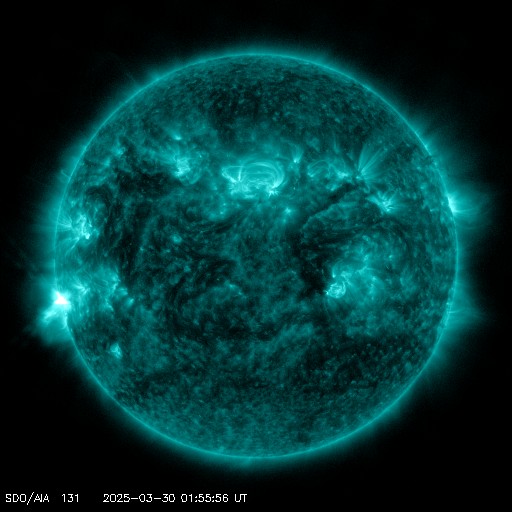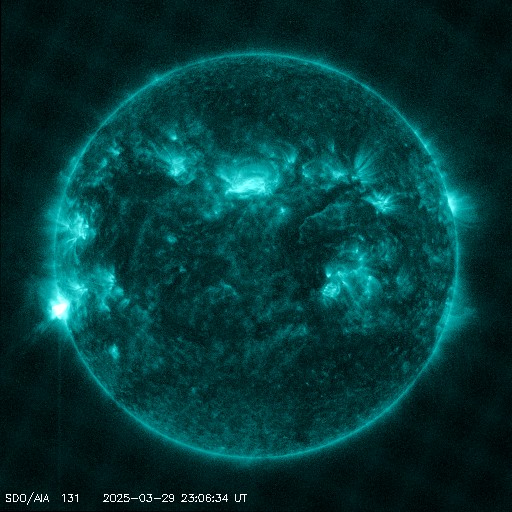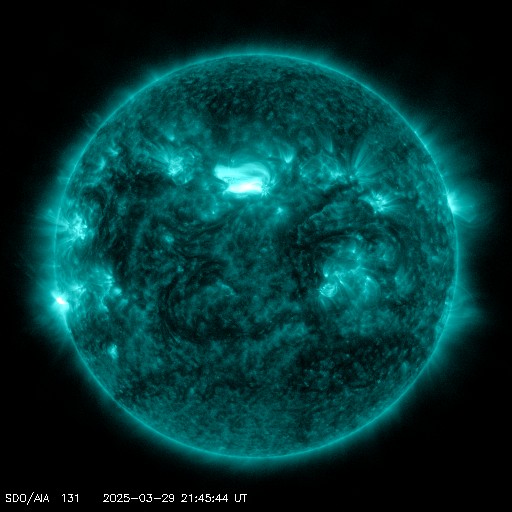Viewing archive of Thursday, 7 June 2012
Solar activity report
Any mentioned solar flare in this report has a scaling factor applied by the Space Weather Prediction Center (SWPC). Because of the SWPC scaling factor, solar flares are reported as 42% smaller than for the science quality data. The scaling factor has been removed from our archived solar flare data to reflect the true physical units.
Report of Solar-Geophysical Activity 2012 Jun 07 2200 UTCPrepared by the NOAA © SWPC and processed by SpaceWeatherLive.com
Joint USAF/NOAA Report of Solar and Geophysical Activity
SDF Number 159 Issued at 2200Z on 07 Jun 2012IA. Analysis of Solar Active Regions and Activity from 06-2100Z to 07-2100Z
Solar activity was low. Several C-class flares were
observed over the past 24 hours. The largest was a C9/2n flare
observed at 07/1543Z from Region 1499 (N15W09). This region
produced five other low level C-class flares during the period.
Region 1494 (S18W19) grew slightly and was also responsible for five
low level C-class flares during the period. These regions were
classied as Cai and Dso type groups, respectively, both with
beta-gamma magnetic characteristics. Region 1497 (S21W44) decreased
in areal extent since yesterday, but remained the largest region on
the disk and was classified as a Dai type group with beta magnetic
characteristics.
IB. Solar Activity Forecast
Solar activity is expected to be low
with a chance for isolated M-class activity.
IIA. Geophysical Activity Summary 06-2100Z to 07-2100Z
The geomagnetic field began at unsettled to active levels, decreasing
to quiet levels for the remainder of the period. The solar wind
speed at the ACE spacecraft decreased from 700 to 600 km/s over the
past 24 hours. The Bz component of the interplanetary magnetic
field ranged between +/- 4nT while the total field remained around 4
nT. The greater than 2 MeV electron flux at geosynchronous orbit was
at high levels throughout the period.
IIB. Geophysical Activity Forecast
The geomagnetic field is
expected to begin the forecast period at unsettled levels with a
chance for active conditons on day one (08 June) as coronal effects
wane and a weak CME from 05 June arrives. Quiet conditions are
expected on day two (09 June) followed by a return to unsettled
conditions with a chance for active periods on day three (10 June)
with the potential arrival of a CME from 06 June.
III. Event Probabilities 08 Jun to 10 Jun
| Class M | 30% | 25% | 25% |
| Class X | 01% | 01% | 01% |
| Proton | 01% | 01% | 01% |
| PCAF | Green | ||
IV. Penticton 10.7 cm Flux
Observed 07 Jun 128 Predicted 08 Jun-10 Jun 130/130/130 90 Day Mean 07 Jun 117
V. Geomagnetic A Indices
Observed Afr/Ap 06 Jun 017/017 Estimated Afr/Ap 07 Jun 007/008 Predicted Afr/Ap 08 Jun-10 Jun 007/008-006/005-007/010
VI. Geomagnetic Activity Probabilities 08 Jun to 10 Jun
| A. Middle Latitudes | |||
|---|---|---|---|
| Active | 20% | 10% | 20% |
| Minor storm | 10% | 05% | 10% |
| Major-severe storm | 01% | 01% | 01% |
| B. High Latitudes | |||
|---|---|---|---|
| Active | 15% | 15% | 15% |
| Minor storm | 25% | 15% | 25% |
| Major-severe storm | 30% | 15% | 30% |
All times in UTC
Current data suggests there is a slight possibility for aurora to appear at the following high latitude regions in the near future
Gillam, MB, Yellowknife, NTLatest news
Latest forum messages
AR4046 129AR4048 20AR4043 47Incoming & Unnumbered Active Regions 1658Aurora photography hints for those of us with smartphones 51
More topicsSupport SpaceWeatherLive.com!
A lot of people come to SpaceWeatherLive to follow the Sun's activity or if there is aurora to be seen, but with more traffic comes higher server costs. Consider a donation if you enjoy SpaceWeatherLive so we can keep the website online!

Latest alerts
02:09 UTC - Solar flare
Moderate M1.54 flare from sunspot region 4048
01:42 UTC - Radio Blackout
Minor R1 radio blackout in progress (≥M1 - current: M1.24)
Saturday, 29 March 2025
23:21 UTC - Solar flare
Moderate M1.91 flare from sunspot region 4048
22:51 UTC - Radio Blackout
Minor R1 radio blackout in progress (≥M1 - current: M1.1)
21:57 UTC - Solar flare
Moderate M1.45 flare from sunspot region 4048
Space weather facts
| Last X-flare | 2025/03/28 | X1.1 |
| Last M-flare | 2025/03/30 | M1.5 |
| Last geomagnetic storm | 2025/03/27 | Kp5 (G1) |
| Spotless days | |
|---|---|
| Last spotless day | 2022/06/08 |
| Monthly mean Sunspot Number | |
|---|---|
| February 2025 | 154.6 +17.6 |
| March 2025 | 127.5 -27.1 |
| Last 30 days | 127.5 -24.7 |





